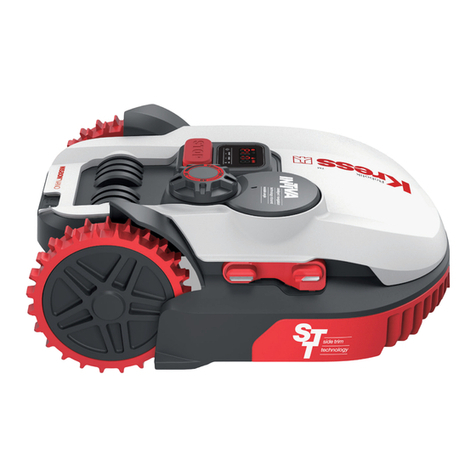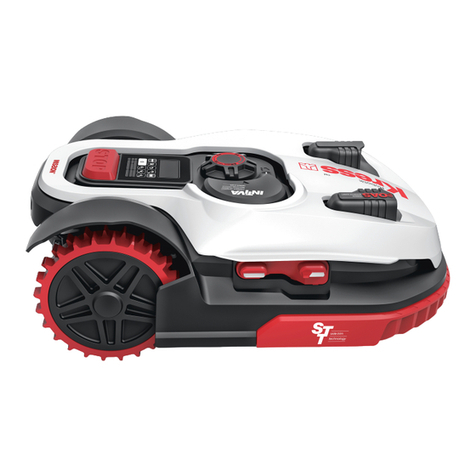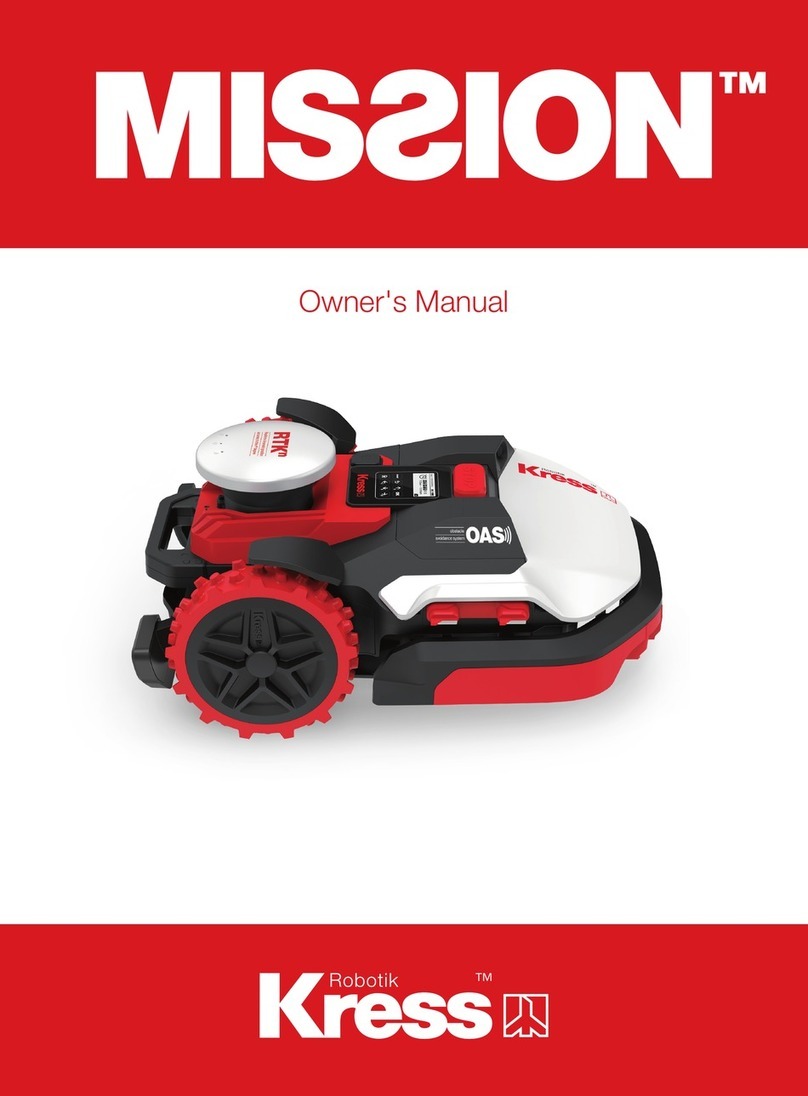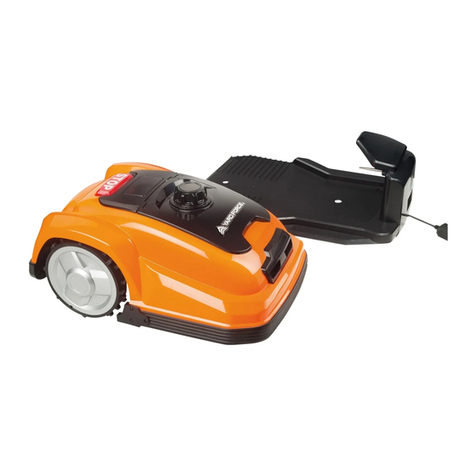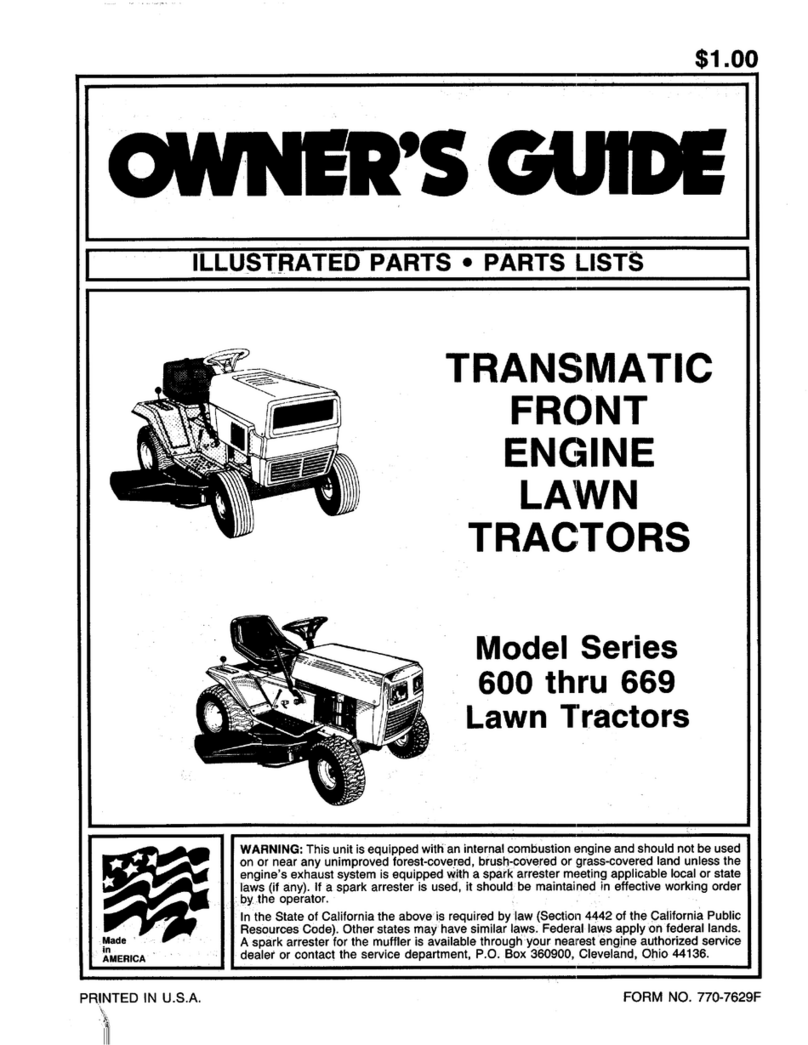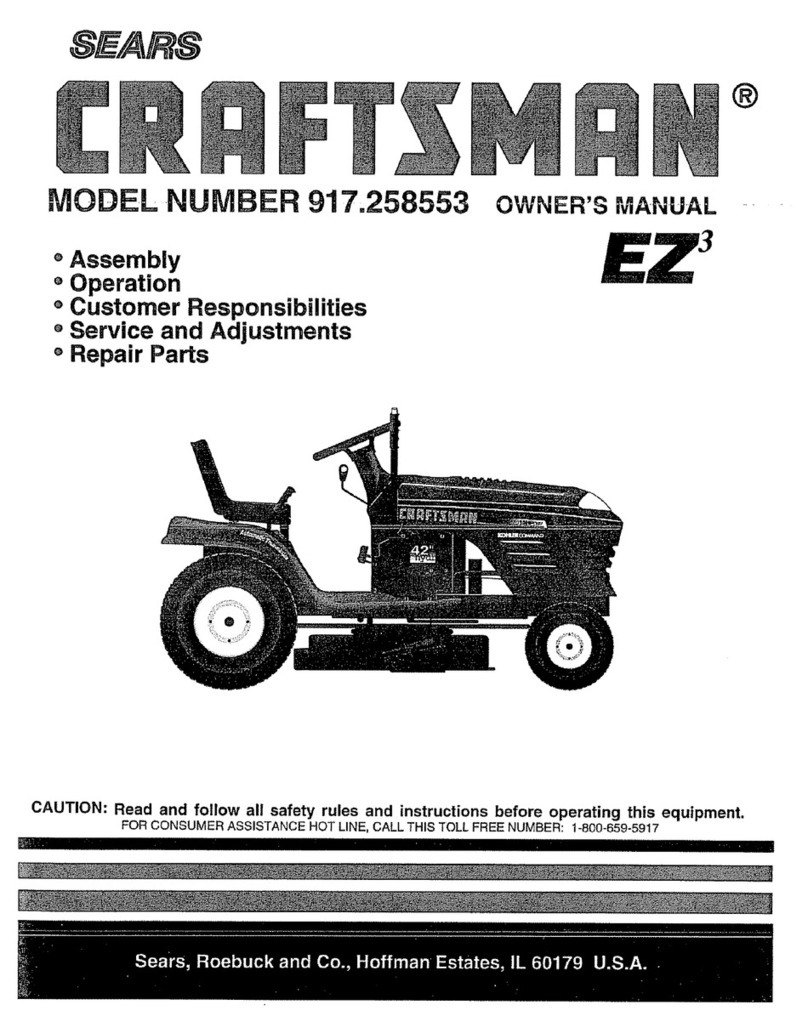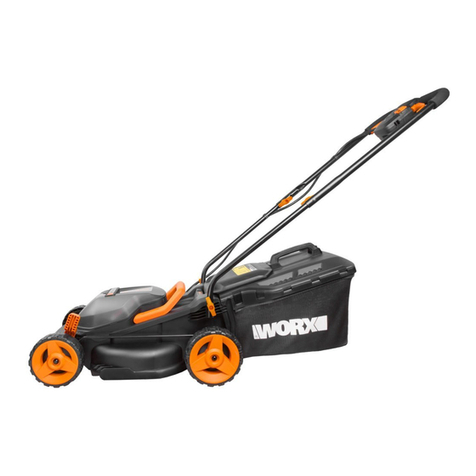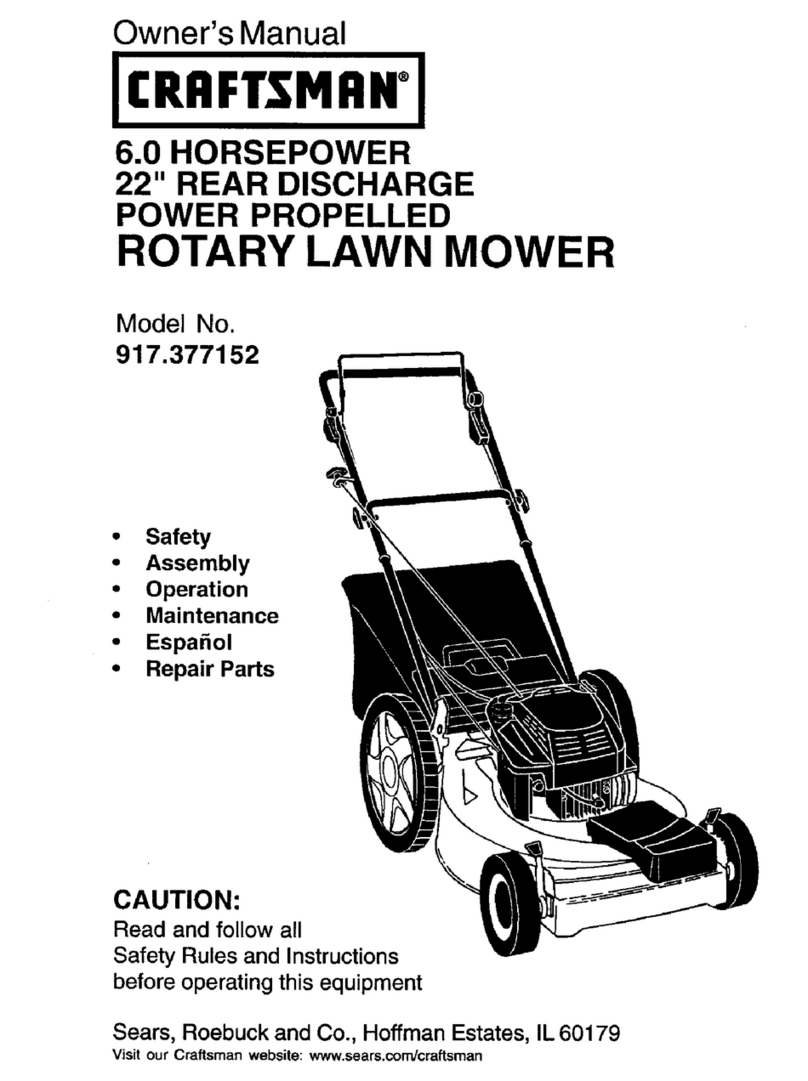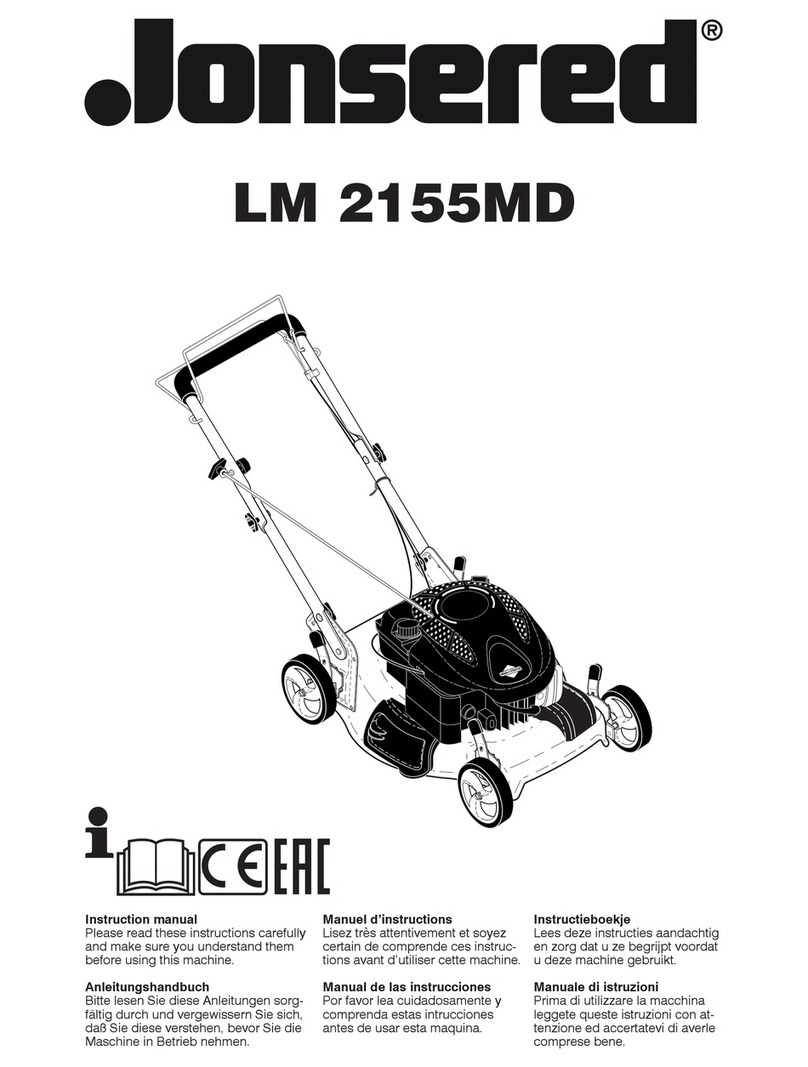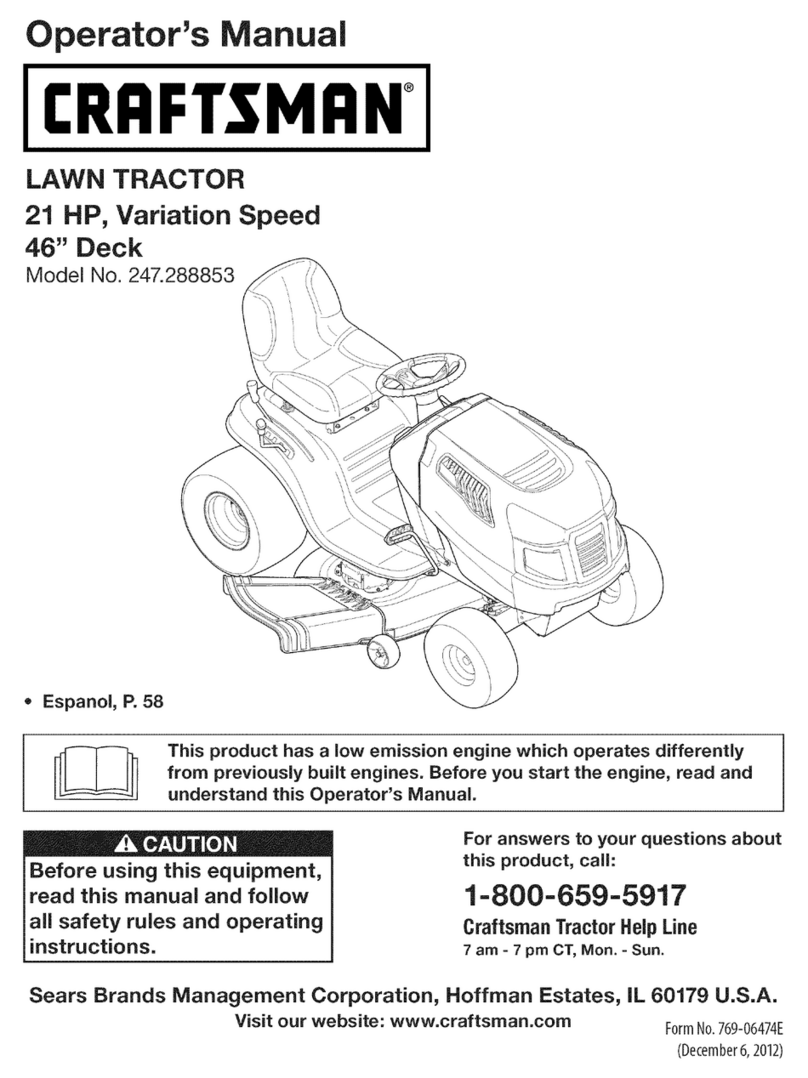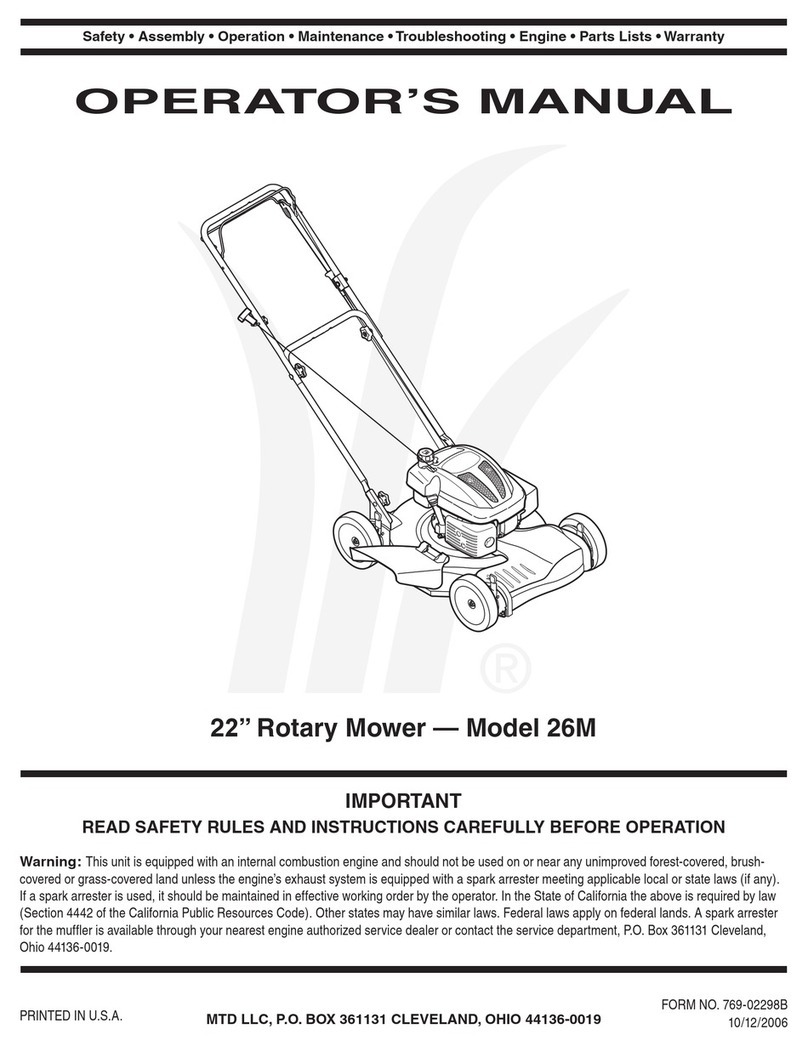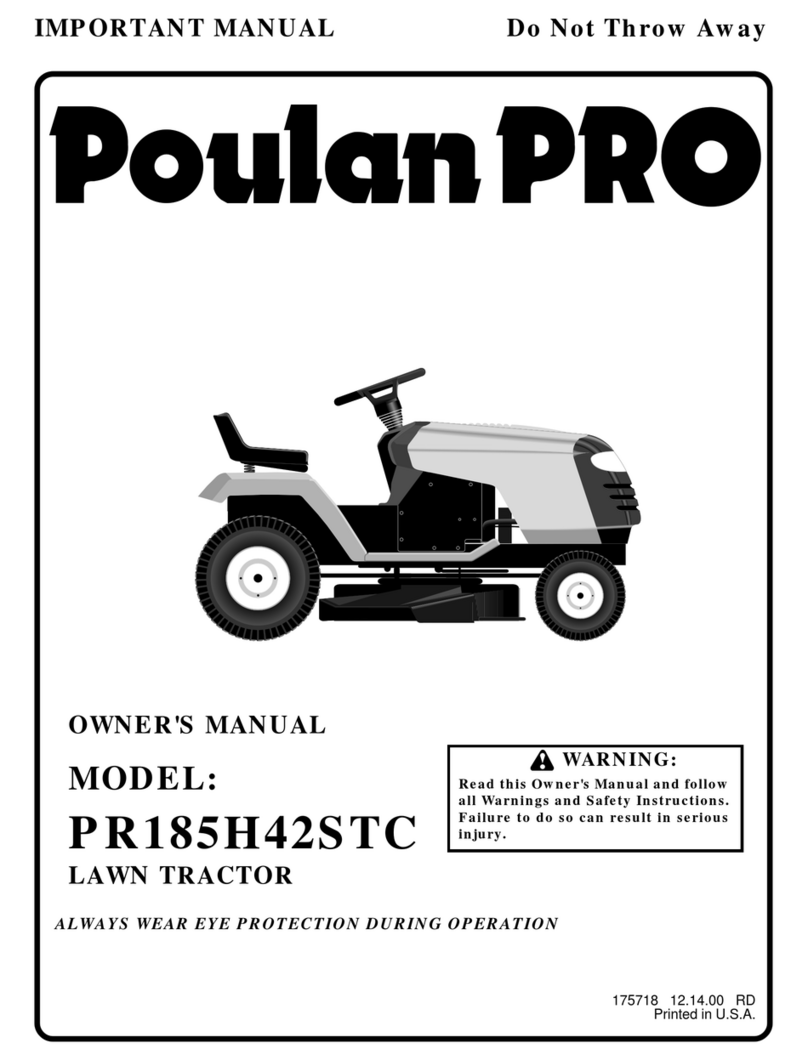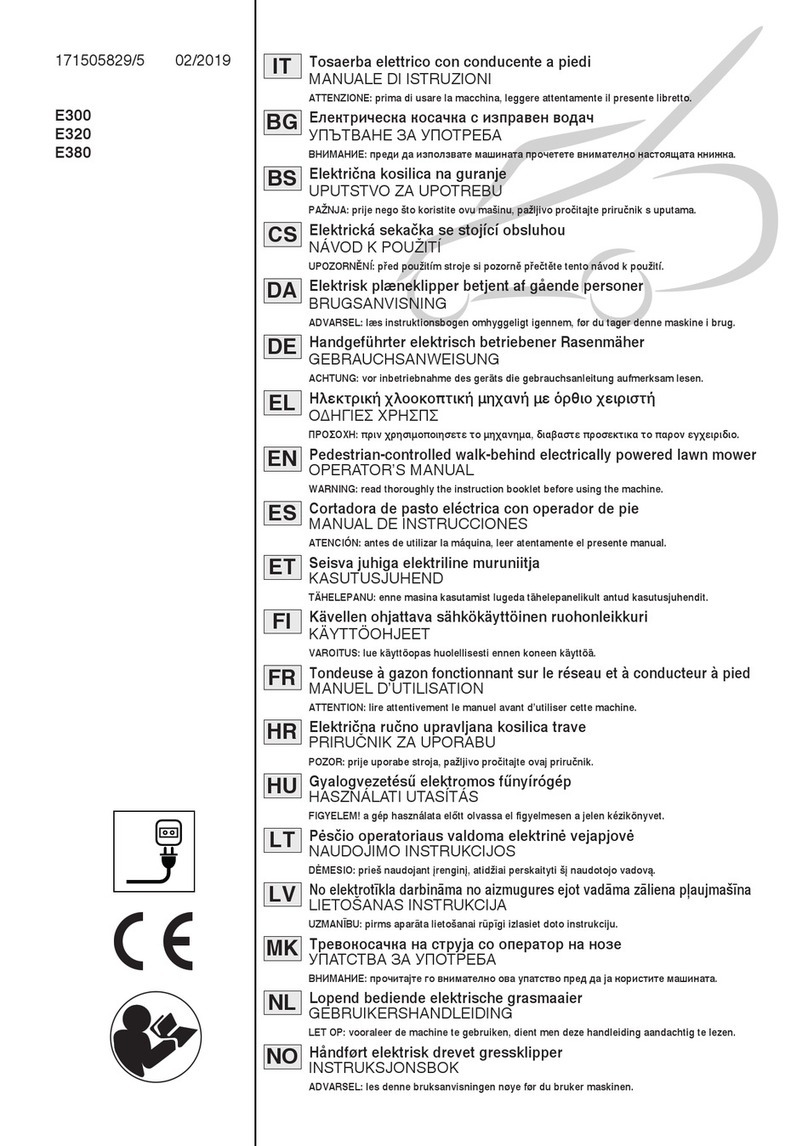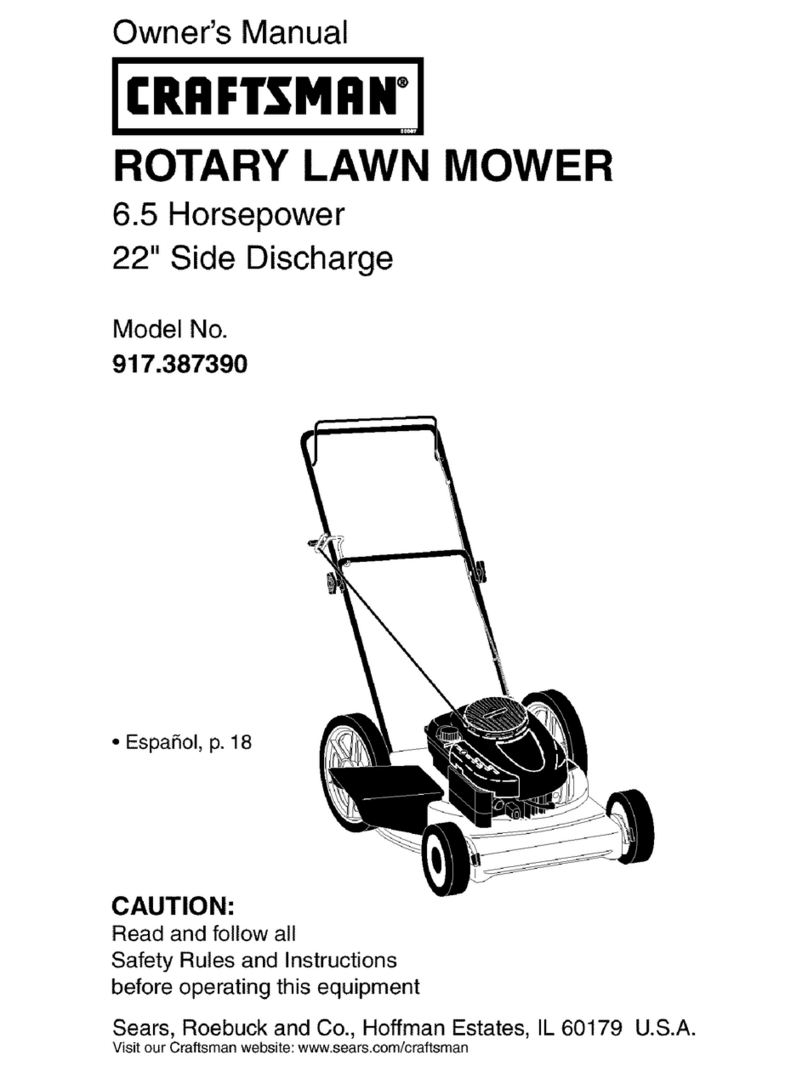Kress Robotik Mission Mega RTKn 4 1/2 User manual

Owner's Manual


Owner's Manual P04
Manuel utilisateur P17
Instrucciones de usuario P31
KR233
En
F
Es

4
EN
WARNING: Some dust created by
power sanding, sawing, grinding,
drilling and other construction activities
contains chemicals known to the State of
California to cause cancer, birth defects or
other reproductive harm. Some examples
of these chemicals are:
• Lead from lead-based paints;
• Crystalline silica from bricks and cement
and other masonry products;
• Arsenic and chromium from chemically-
treated lumber.
Your risk from these exposures varies,
depending on how often you do this type
of work. To reduce your exposure to these
chemicals: work in a well ventilated area,
and work with approved safety equipment,
such as those dust masks that are
specially designed to filter out microscopic
particles.
WARNING: This product can expose
you to chemicals including lead and
Di(2-ethylhexyl)phthalate (DEHP) which are
known to the State of California to cause
cancer and birth defects or other
reproductive harm. For more information
go to www.P65Warnings.ca.gov.
WARNING: Read all safety warnings
and all instructions.
Failure to follow the
warnings and instructions may result in electric
shock, fire and/or serious injury.
Carefully read the instructions for the safe
operation of the machine.
Save all warnings and instructions for
future reference.
- This appliance is not intended for use by
persons (including children) with reduced
physical, sensory or mental capabilities,
or lack of experience and knowledge,
unless they have been given supervision or
instruction concerning use of the appliance
by a person responsible for their safety.
- Children should be supervised to ensure that
they do not play with the appliance.
WARNING: For the purposes of recharging
the battery, only use the detachable supply
unit provided with this appliance.
IMPORTANT
READ CAREFULLY BEFORE USE
KEEP FOR FUTURE REFERENCE
Safe operation practices
Training
a) Read the instructions carefully. Make sure you
understand the instructions and be familiar
with the controls and the proper use of the
appliance.
b)
Never allow people unfamiliar with these
instructions or children to use the appliance.
Local regulations can restrict the age of the
operator.
c) The operator or user is responsible for
accidents or hazards occurring to other
people or their property.
Preparation
a) Confirm that the virtual boundary is
established as instructed and the virtual
boundary is regularly maintained. Before each
working cycle, the machine goes around the
working area to check whether the virtual
boundary exists, if it does not exist, the
machine will shut down. The virtual boundary
specifies the work area where the machine
is allowed to operate. The RTK antena in the
machine senses when it is approaching the
virtual boundary. When the machine hits an
obstacle or approaches the virtual boundary
the product selects a new direction.
b) Periodically inspect the area where the
appliance is to be used and remove all
stones, sticks, wires, bones, and other
foreign objects.
c) Periodically visually inspect to see that the
blades, blade bolts and cutter assembly
are not worn or damaged. Replace worn or
damaged blades and bolts in sets to preserve
balance.
d) On multi-spindle appliances, take care as
rotating one blade can cause other blades to
rotate.
e) WARNING! The lawnmower shall not be
operated without the guard in place.
Operation
1. General
a) Never operate the appliance with defective
guards, or without safety devices, for
example deflectors, in place.
b) Do not put hands or feet near or under
rotating parts. Keep clear of the discharge
opening at all times.
c) Never pick up or carry an appliance while the
motor is running.
d) Operate the disabling device from the
appliance:
- Before clearing a blockage;
- Before checking, cleaning or working on the
appliance;

5
EN
- After striking a foreign object to inspect the
machine for damage;
- If the machine starts to vibrate abnormally,
and to check for damage before restarting.
e) It is not permitted to modify the original
design of robotic lawnmower. All
modifications are made at your own risk.
f) Start robotic lawnmower according to the
instructions. When the power is on, make
sure you keep your hands and feet away from
the rotating blades. Never put your hands
and feet under the mower.
g) Never lift up robotic lawnmower or carry it
when the power is on.
h) Do not let persons who do not know how
robotic lawnmower works and behaves use
the mower.
i) Do not put anything on top of robotic
lawnmower or its charging base.
j)
Do not allow robotic lawnmower to be used
with a defective blade disc or body. Neither
should it be used with defective blades,
screws, nuts or cables.
k)
Always switch off robotic lawnmower when
you do not intend to use the mower. Robotic
lawnmower can only start when the power
is on and the correct PIN code has been
entered.
l) Keep your hands and feet away from the
rotating blades. Never place your hands or
feet close to or under the body when robotic
lawnmower is in operation.
m)To avoid using the machine and its
peripherals in bad weather conditions
especially when there is a risk of lightning.
n) Not to touch moving hazardous parts before
these have come to a complete stop.
o) For machines used in public areas, that
warning signs shall be placed around the
working area of the machine. They shall show
the substance of the following text:
Warning! Automatic lawnmower! Keep away
from the machine! Supervise children!
2. Additionally when the appliance is
operating automatically
a) Do not leave the machine to operate
unattended if you know that there are pets,
children or people in the vicinity.
Maintenance and storage
WARNING! When the mower is turned
upside down the power must always
be off.
The power should be off during all work on
the mower’s underframe, such as cleaning
or replacing the blades.
a) Keep all nuts, bolts and screws tight to
be sure the appliance is in safe working
condition.
b) Inspect the robotic lawnmower each week
and replace worn or damaged parts for
safety.
c) Check especially that the blades and blade
disc are not damaged. Replace all blades and
screws at the same time if necessary so that
the rotating parts are balanced.
d) Ensure that only replacement cutting means
of the right type are used.
e) Ensure that batteries are charged using
the correct charger recommended by the
manufacturer. Incorrect use may result in
electric shock, overheating or leakage of
corrosive liquid from the battery.
f) In the event of leakage of electrolyte flush with
water/neutralizing agent, seek medical help if
it comes into contact with the eyes etc.
g) Servicing of the appliance should be
according to manufacturers’ instructions.
Recommendation
To connect the machine and/or its peripherals
only to a supply circuit protected by a residual
current device (RCD ) with a tripping current of
not more than 30 mA.
Residual risks
To avoid injuries, wear protective gloves when
replacing the blades.
Transport
The original packaging should be used when
transporting robotic lawnmower over long
distances.
To safely move form or within the working area:
a) Press the STOP button to stop the mower.
You select the four digit PIN code when you
start the mower for the first time.
b) Always switch off robotic lawnmower if you
intend to carry the mower.
c) Carry the mower by the handle at the rear
under the mower. Carry the mower with the
blade disc away from the body.
Safety Warnings for battery pack inside the
tool
a)
Do not dismantle, open or shred battery
pack.
b) Do not expose battery pack to heat or
fire. Avoid storage in direct sunlight
c) Do not short-circuit a battery pack. Do

6
EN
not store battery packs haphazardly
in a box or drawer where they may
short-circuit each other or be short-
circuited by other metal objects. When
battery pack is not in use, keep it away
from other metal objects, like paper clips,
coins, keys, nails, screws or other small
metal objects, that can make a connection
from one terminal to another. Shorting
the battery terminals together may cause
burns or fire.
d) Do not subject battery pack to
mechanical shock.
e) In the event of battery leaking, do not
allow the liquid to come in contact
with the skin or eyes. If contact has
been made, wash the affected area
with copious amounts of water and
seek medical advice.
f) Do not use any battery pack which
is not designed for use with the
equipment.
g) Keep battery pack out of the reach of
children.
h) Always purchase the battery
pack recommended by the device
manufacturer for the equipment.
i) Keep battery pack clean and dry.
j) Wipe the charging terminals with a
clean dry cloth if they become dirty.
k) Battery pack need to be charged
before use. Always use the
correct charger and refer to the
manufacturer’s instructions or
equipment manual for proper charging
instructions.
l) Do not leave battery pack on
prolonged charge when not in use.
m)Recharge only with the charger
specified by Kress. Do not use any
charger other than that specifically
provided for use with the equipment.
n) Retain the original product literature
for future reference.
o) Use only the battery pack in the
application for which it was intended.
p) Dispose of properly.
q) Do not mix cells of different
manufacture, capacity, size or type
within a device.
r) Keep the battery away from
microwaves and high pressure.

7
EN
Symbols
WARNING – robotic lawnmower can be dangerous if incorrectly used. Read through
the Operator’s manual carefully and understand the content before using your robotic
lawnmower.
WARNING - Keep a safe distance from the machine when operating.
WARNING – Activate the disabling device before working on or lifting the machine.
WARNING – Do not ride on the machine.
Class III appliance
Li-Ion battery, battery must be recycled.
Do not burn.
Batteries may enter water cycle if disposed improperly, which can be hazardous for
ecosystem. Do not dispose of waste batteries as unsorted municipal waste.
Do not wash the machine with a high pressure washer
Prohibit disassembling the machine without authorization.
POSITEC Inc. has established a partnership with the RBRC Corporation to recycle any
Positec batteries with the RBRC-call2recycle seal. For environmental protection, please
do not discard batteries in the trash. After the batteries' life cycle is ended, then please call
1-800-822-8837 for a free service that will properly dispose of the battery.

8
EN
Component list
Wed.11/2909:00PM
Wed.11/29 09:00PM
32
1
4
16
17
21 22 23
19
24
9
18
15
12 11
20
25
14
6
5
8
7
10
13

9
EN
1. Ultrasonic Sensor 14. Cutting Blade
2. Charging Strips 15. Charging Pile
3. Rear Driving Wheel 16. Contact Pins
4. Rain Sensor 17. Charging Base
5. STOP Button 18. Power Adapter
6. Display 19. Charging Base Fixing Nails
7. Keypad 20. RTK Antenna
8. ON/OFF Key 21. Hex Key
9. START Key 22. Wrench for RTK antenna
10. Front Wheel 23. Magnetic Strip
11. Blade Turning Disc 24. Staples
12. Battery Pack* 25. Hexagon Screwdriver
13. Handle
*Not all the accessories illustrated or described are included in standard delivery.
Technical Data
Type KR233 (100-299 - designation of machinery, representative of Robotic Lawnmower)
KR233
Rated voltage 20V Max.*
No load speed 3200/min
Cutting area 3 acre
Cutting diameter 13.8'' (35cm)
Cutting height 1.18'' – 3.54'' (30mm-90mm)
Cutting Height Positions 7
Battery type Lithium-ion
Battery model KA3010
Charging time approx. 62 min.
Charger model KA3727
Charger rating Input: 100-240V~50/60Hz, 230W,
Output: 28V, 7.0A
Machinery weight 20 kg
Protection degree III
App Y
Maximum slope within the work surface 40%
* Voltage measured at no load. Initial battery voltage reaches maximum of 20 volts. Nominal voltage is 18 volts.

10
EN
Technical Data For Antenna
Rated voltage 5V±2%
Operating temperature -40°C~85°C
Storage temperature -40°C~85°C
Band Tx(Mhz) Rx(Mhz) RF Output Power (Max)
EGSM900(B8) 880-915 925-960 33dBm±2dB
DCS1800(B3) 1710-1785 1805-1880 30dBm±2dB
WCDMA B1 1920-1980 2110-2170 24dBm+1/-3dB
WCDMA B8 880-915 925-960 24dBm+1/-3dB
LTE-FDD B1 1920-1980 2110-2170 23dBm±2dB
LTE-FDD B3 1710-1785 1805-1880 23dBm±2dB
LTE-FDD B7 2500-2570 2620-2690 23dBm±2dB
LTE-FDD B8 880-915 925-960 23dBm±2dB
LTE-FDD B20 832-862 791-821 23dBm±2dB
LTE-FDD B28 703-748 758-803 23dBm±2dB
LTE-TDD B38 2570-2620 2570-2620 23dBm±2dB
LTE-TDD B40 2300-2400 2300-2400 23dBm±2dB
LTE-TDD B41 2555-2655 2555-2655 23dBm±2dB
Accessories
KR233
Screws for fixing disk 6
Screws for fixing blades 36
Charging base 1
Charging base fixing nails 8
Hex key 1
Wrench for RTK antenna 1
Magnetic strip 1
Blade 36
RTK antenna 1
Hexagon screwdriver 1

11
EN
Measurement gauge 1
Staples 16
Battery pack (KA3010) 1
Charger (KA3727) 1
We recommend that you purchase genuine accessories listed in the above list from the same store that sold
you the tool. Refer to the accessory packaging for further details. Store personnel can assist you and offer
advice.
Intended Use
The garden product is intended for lawn mowing. It is designed to mow often, maintaining a healthier and
better looking lawn than ever before. Depending on the size of your lawn, MissionTM RTKnmay be programmed
to operate at any time or frequency. It is not intended for digging, sweeping or snow cleaning.

12
EN
1
Keep it Sharp
WARNING: Before cleaning, adjusting, or replacing the blades, turn your Mission
TM
RTK
n
OFF
and put on protective gloves.
WARNING: When fitting new blades, make sure you replace ALL the blades. Always use new
screws when fitting blades. This is important to ensure blade retention and balance the blade
turning disc. Failure to use new screws could cause serious injury.
The
MissionTM RTKn
does not cut grass like other
mowers. Its cutting blades are razor sharp on 2 edges
and rotate in both directions for maximum cutting
capacity. Redesigned blade profile better prevents grass
clippings from getting caught in the gap between the
disc and the blade. And with new material, the service
life of each cutting blade will be longer than that of
other brands’ when it is programmed to mow every
day. Always check to see if the blades are chipped or
damaged and replace them if they are. When the cutting
blades are dull and worn out, they should be replaced
with the spare blades provided with your
MissionTM
RTKn
. Spare blades are also available at your nearest
Kress retailer.
1
2
Before attempting to replace your MissionTM RTKn’s
blades, turn the power off and put on protective gloves
and follow these steps:
1. Gently flip the MissionTM RTKnover.
2. Remove the battery cover and remove the battery.
3. Take the 3 screws for fixing disk from each disk off
seperately with a hexagon screwdriver.
4. Remove the two disks.
5. Take the 6 screws for fixing blades off with a
Usually your MissionTM RTKn's blades need to be
replaced every week, you can adjust the frequency
of replacing the blade according to the cutting quality
of the lawn. When replacing the blades, make sure to
replace all of them at the same time. You can replace
them with one of the spare blade kits and extra blade
screws supplied with your MissionTM RTKn.
A. Replace the blades
Maintenance
Your MissionTM RTKnworks hard and needs to be cleaned and checked from time to time. Some parts will
require replacement as they become worn. Never use your MissionTM RTKnwith defective on/off switch.
Switch off the machine before carrying out any service or maintenance.
Here's how to take care of your MissionTM RTKn.

13
EN
Your MissionTM RTKnwill live a much happier and longer life if it is cleaned regularly. Since your MissionTM RTKn
is an electric machine, you will need to take care when cleaning. Hose water clean is supported. It is best to
use a spray bottle filled with water. When cleaning the machine body, use a soft brush or clean cloth and avoid
using solvents or polishes. Lastly, remove all build up of grass clippings and debris.
Clean the contact pins located on the charging
base and the charging strips located on the
MissionTM RTKnusing a cloth. Remove any built
up grass clippings or debris around the contact
pins and charge strips periodically to ensure the
MissionTM RTKnsuccessfully charges each time.
Again, it is important that you power the MissionTM
RTKnOFF and wear protective gloves before
touching the blade turning disc. First, flip
your MissionTM RTKnupside down to expose its
underside. Here you will see the blade disc, the
chassis, and the front wheel and driving wheels.
Clean everything thoroughly with a soft brush or
moist rag. Hose water clean is supported.
Rotate the blade disc to ensure it rotates freely.
Check the blades spin freely around the fixing
screws. Remove any obstructions.
IMPORTANT: Remove any stuck debris so
that it does not cause a crack in the blade
disc. Even the tiniest crack can decrease your
MissionTM RTKn's mowing output.
A. Cleaning the Body
C. Clean the contact pins and the charging strips
B. Cleaning the underside
WARNING: Before cleaning, turn your MissionTM RTKnOFF. Put on protective gloves before
cleaning the blade turning disc and do not rinse or flush with water.
WARNING! YOUR MissionTM RTKncan only be washed by using a hose! DO NOT use high
pressure washer on your MissionTM RTKn. High pressure water can go inside the sealings and
damage electronic and mechanical parts.
Keep it Clean
2
screwdriver and remove the blades.
6. Firmly screw on the new blades and new screws for fixing blades.
7. Refit and firmly screw on the disks on the underside of MissionTM RTKn.
8. Refit the battery and the battery cover.
Important: After screwing the blade to the blade disc, make sure the blade is able to spin freely.

14
EN
1. Connect the charging base to a suitable power
supply. The green light on the charging base will
turn on.
2. Manually dock the MissionTM RTKninto the charging
base while the MissionTM RTKnis powered off.
3. The green light on the charging base will be flashing
and MissionTM RTKnwill begin to charge.
MissionTM RTKncan be charged manually.
Your
MissionTM RTKn
will live longer and healthier if it is allowed to hibernate. So even though it is tough, we
recommend storing your
MissionTM RTKn
in your shed or garage during the winter.
Before you prepare your
MissionTM RTKn
for winter hibernation, we recommend you:
• Thoroughly clean your
MissionTM RTKn
• Fully charge the battery
• Turn the power off
To maximize the battery life, fully charge the battery before storage during winter.
WARNING: Protect the underside of Mission
TM
RTK
n
from water. NEVER store Mission
TM
RTK
n
upside down outdoors.
NOTE: When bringing the
MissionTM RTKn
back to work after winter hibernation, make sure the charging strips
and contact pins are clean. We recommend using a fine grade emery cloth to clean the contacts. Using the
app, make sure the date and time are correct and send
MissionTM RTKn
back to what it loves doing: mowing.
Winter Hibernation
4
The heart of the MissionTM RTKnis its 20V Li-Ion Battery. For proper storage of the battery, make sure it is fully
charged and kept in a cool dry place between (-20oC~+60oC).
NOTE: The recommended MissionTM RTKnoperation temperature is between 0-55oC.
The life-span of the MissionTM RTKn’s battery depends on various factors, such as:
• The length of the mowing season in your region
• Amount of hours the MissionTM RTKnmows per day
• Battery maintenance during storage
Battery Life
3

15
EN
1. Gently turn your MissionTM RTKnupside down.
2. Remove the screws on the battery cover.
Remove the battery cover.
3. Remove the screws on the sheet metal.
Remove the sheet metal.
If you need to replace the battery, follow these
steps:
4.
Unplug the connector. Replace the old battery
with the new one. Then plug the connector.
5. Refit the sheet metal. Place the cover back in
its position and tighten the screws.
WARNING: Power off before attempting any adjustment, replacement or repair.
Before replacing the blades, turn your MissionTM RTKnOFF and put on protective gloves.
Replacing the battery
5

16
EN
Troubleshooting
If your MissionTM RTKndoes not work correctly, follow the trouble shooting guide below. If the fault persists,
contact your dealer.
Symptom Cause Solution
The LED light on the charging
base does not turn on. There is no power.
Check the charging base is connected
properly to the charger and the charger
is connected to a suitable power supply.
MissionTM RTKncannot
correctly dock with the
charging base.
The magnetic strip is placed in
the wrong direction.
Check if the magnetic strip is placed
in the wrong direction. When correctly
placed, the green stripe of the magnetic
strip is facing away from the charging
base.
Machine runs out of power but
does not return to charging
base.
No virtual charging base is
mapped.
Rebuild the map and add the virtual
charging base.
The length of the magnetic strip
is less than 8.2' (2.5 m).
The length of the magnetic strip should
be guaranteed to be greater than 8.2'
(2.5 m).
When MissionTM RTKnis going
downhill, it overruns the
boundary line.
The angle of the border line is
very sharp.
Try to avoid layout scenarios with sharp
angles.
After MissionTM RTKnis turned
on, the start button is pressed,
but MissionTM RTKndoes not
work.
MissionTM RTKnis outside the
working area.
Move MissionTM RTKninside the working
area.
Poor positioning signal
Find an open place, wait for the
positioning signal light to turn green,
and then press start button.
MissionTM RTKndoes not give
an alarm when it is outside the
Geo fence.
The software of MissionTM RTKn
itself is not the latest.
Update the software of the MissionTM
RTKn.
MissionTM RTKnis powered off. Turn MissionTM RTKnon.
MissionTM RTKnis parked in
the middle of the obstacle.
The obstacles around MissionTM
RTKnare relatively small, and
MissionTM RTKnfails to get out
of trouble.
Set the area where MissionTM RTKnis
easily trapped as No-Go.
The sensor of MissionTM RTKnis
abnormal
Detect MissionTM RTKn's diagnostic
page on the APP and check the sensor
status.
Unable to read log. The format of U-disk is not
FAT32.Convert the format of U-disk to FAT32.
MissionTM RTKnis parked
around the wall and cannot be
started, and the positioning
light is always on red.
MissionTM RTKnworks in the
shaded area for too long,
triggering the safety protection. Try to avoid letting MissionTM RTKnmow
in areas with too much shade.
There are too many walls or
trees in the area, blocking the
positioning signal.

17
F
AVERTISSEMENT: Certaines
poussières créées par le ponçage, le
sciage, le meulage, le perçage et autres
activités de construction contiennent des
produits chimiques reconnus par l'État de
Californie comme pouvant causer le
cancer, des anomalies congénitales ou
d'autres problèmes de reproduction.
Quelques exemples de ces produits
chimiques:
• Le plomb provenant des peintures au
plomb;
• La silice cristallisée provenant des
briques et du ciment et d'autres produits
de maçonnerie;
• L'arsenic et le chrome provenant du bois
traité chimiquement.
Les risques que vous encourez résultant
de ces expositions varient selon la
fréquence à laquelle vous effectuez ce type
de travail. Pour réduire votre exposition
à ces produits chimiques : travailler
dans un endroit bien ventilé, et porter
un équipement de sécurité approprié tel
que certains masques antipoussières qui
sont spécialement conçus pour filtrer les
particules microscopiques.
AVERTISSEMENT: Ce dispositif peut
vous exposer aux produits chimiques
notamment le plomb et le di-phtalate (de
2-éthylhexyle) (DEHP) qui sont reconnus
dans l'État de Californie comme causant
des cancers et des anomalies congénitales
ou d’autres anomalies de la reproduction.
Pour en savoir plus, veuillez consulter le
site www.P65Warnings.ca.gov.
AVERTISSEMENT: Veuillez lire toutes
les consignes de sécurité et les
instructions.
Le non-respect des
avertissements et instructions peut entraîner un
choc électrique, un incendie et/ou des blessures
graves.
Lisez attentivement les instructions pour
assurer le fonctionnement en toute sécurité
de la machine.
Conservez tous les avertissements et les
instructions pour une référence future.
- Cet appareil n'est pas destiné à être utilisé
par des personnes (y compris les enfants)
dont les capacités physiques, sensorielles
ou mentales sont réduites, sans expérience
et/ou aux compétences insuffisantes,
sauf si elles ont été encadrées concernant
l'utilisation de l'appareil par une personne
responsable de leur sécurité.
- Les enfants doivent être surveillés pour
s'assurer qu'ils ne jouent pas avec l'appareil.
AVERTISSEMENT: Aux fins de la recharge
de la batterie, utilisez uniquement l'unité
d’alimentation détachable fournie avec cet
appareil.
IMPORTANT
LISEZ ATTENTIVEMENT AVANT
L'UTILISATION
CONSERVEZ POUR UNE RÉFÉRENCE
FUTURE
Consignes de sécurité
Formation
a) Lisez attentivement les instructions. Assurez-
vous de bien comprendre les instructions et
de vous familiariser avec les commandes et la
bonne utilisation de l'appareil.
b)
Ne laissez jamais les personnes peu familières
avec ces instructions ou les enfants utiliser
l'appareil. Les réglementations locales
peuvent limiter l'âge de l'opérateur.
c) L'opérateur ou l'utilisateur est responsable
des accidents ou dommages causés à
d'autres personnes ou à leurs biens.
Préparations
a) Confirmez que le périmètre virtuel est établi
conformément aux instructions et que le
périmètre virtuel est régulièrement entretenu.
Avant chaque cycle de travail, la machine fait
le tour de la zone de travail pour vérifier si le
périmètre virtuel existe, s'il n'existe pas, la
machine s'arrête. La frontière virtuelle spécifie
la zone de travail dans laquelle la machine
est autorisée à opérer. L'antenne RTK de
la machine détecte quand elle s'approche
des limites virtuelles. Lorsque la machine
rencontre un obstacle ou s'approche d'une
limite virtuelle, elle sélectionne une nouvelle
direction.
b) Inspectez périodiquement la zone où
l'appareil doit être utilisé et enlever toutes
les pierres, bâtons, fils, os et autres objets
étrangers.
c) Inspectez visuellement de façon périodique
pour voir si les lames, les boulons de lame
et le carter de coupe ne sont pas usés ou
endommagés. Remplacez les lames ou les
boulons usés ou endommagés dans des
ensembles pour préserver l'équilibre.
d) Sur les appareils multibroches, sachez que la
rotation d'une lame peut entraîner celle des

18
F
autres lames.
e) AVERTISSEMENT! La tondeuse ne doit pas
être utilisée sans l'installation adéquate de la
garde.
Fonctionnement
1. Généralités
a) Ne jamais faire fonctionner l'appareil des
gardes défectueuses ou sans dispositifs de
sécurité, par exemple des déflecteurs, en
place.
b) Ne mettez pas les mains ou les pieds près ou
sous les pièces rotatives. Restez à l'écart de
l'ouverture de décharge à tout moment.
c) Ne soulevez ou portez jamais un appareil
pendant que le moteur est en marche.
d) Faites fonctionner le dispositif de
désactivation de l'appareil:
- Enlever l'objet à l'origine du blocage;
- Contrôler, nettoyer ou travailler sur l'appareil;
- Après avoir heurté un objet, vérifiez que la
machine n'est pas endommagée;
- Si la machine se met à vibrer anormalement,
et vérifiez l'absence de dommages avant de
redémarrer.
e) Il n'est pas autorisé de modifier la conception
originale de la tondeuse à gazon robot.
Toutes les modifications sont effectuées à vos
propres risques.
f) Démarrez la tondeuse à gazon robot selon
les instructions. Lorsque le bouton de mise
sous tension est allumé, assurez-vous de
garder vos mains et pieds éloignés des lames
pivotantes. Ne mettez jamais vos mains et
vos pieds sous la tondeuse.
g) N'essayez jamais de soulever la tondeuse
robot ou de la porter lorsque le bouton de
mise sous tension est allumé.
h) Ne laissez pas les personnes qui ont des
connaissances réduites sur le fonctionnement
et le comportement des tondeuses à gazon
robot utiliser la tondeuse.
i) Ne posez rien au-dessus de la tondeuse
robot ou sa station de charge.
j)
N'autorisez pas l'utilisation de la tondeuse
robot avec un disque de coupe ou un carter
défectueux. Elle ne doit pas être utilisée avec
des lames, vis, écrous ou câbles défectueux.
k)
Mettez toujours la tondeuse robot hors tension
lorsque vous n'avez pas l'intention de l'utiliser.
La tondeuse robot peut démarrer uniquement
si le bouton de mise sous tension est allumé et
le code PIN correct a été saisi.
l) Maintenez vos mains et vos pieds éloignés
des lames tournantes. Ne placez jamais vos
mains ou vos pieds auprès du ou sous le
corps lorsque la tondeuse robotique est en
marche.
m)Évitez d'utiliser l’appareil et ses périphériques
dans les conditions météorologiques
mauvaises en particulier lorsqu’il existe des
risques de foudre.
n) Ne touchez pas les parties dangereuses
en mouvement avant qu’elles ne se soient
complètement arrêtées.
o) Pour les machines utilisées dans les lieux
publics, des panneaux d'avertissement
doivent être placés autour de la zone de
travail de la machine. Ils doivent contenir les
éléments essentiels de texte suivant:
Avertissement ! Tondeuse à gazon
automatique ! Ne vous approchez pas de la
machine ! Surveillez les enfants!
2. De plus lorsque l'appareil fonctionne
automatiquement
a) Ne laissez pas la machine fonctionner sans
surveillance si vous savez que des animaux
domestiques, des enfants ou des personnes
se trouvent à proximité.
Entretien et stockage
AVERTISSEMENT! Lorsque la
tondeuse est retournée, le bouton
d'alimentation doit toujours être désactivé.
Le bouton d'alimentation doit toujours
être désactivé pendant tous les travaux
sur le châssis de la tondeuse, comme le
nettoyage ou le remplacement des lames.
a) Maintenez tous les écrous, boulons et vis
bien serrés pour s'assurer que l'appareil est
en bon état de marche.
b) Inspectez la tondeuse à gazon robot chaque
semaine et remplacez les pièces usées ou
endommagées pour la sécurité.
c) Assurez-vous particulièrement que les
lames et le disque de coupe ne sont pas
endommagés. Remplacez toutes les lames
et les vis en même temps si nécessaire pour
assurer le bon équilibre des pièces rotatives.
d) Veiller à ce que seules les pièces de rechange
du matériel de coupe de bonne qualité soient
utilisées.
e) S'assurez que les batteries sont chargées en
utilisant le chargeur adéquat recommandé
par le fabricant. La mauvaise utilisation peut
entraîner un choc électrique, une surchauffe
ou une fuite du liquide corrosif de la batterie.
f) En cas de fuite d'électrolyte avec de l'eau /un
agent de neutralisation, consultez un médecin
en cas de contact avec les yeux etc.
g) L'entretien de l'appareil devrait être effectué

19
F
selon les instructions du fabricant.
Recommandation
Pour raccorder l’appareil et/ou ses périphériques
uniquement à un circuit d’alimentation protégé
par un courant différentiel résiduel (RCD) avec un
courant de déclenchement qui ne dépasse pas
30mA.
Dangers résiduels
Pour éviter les blessures, portez les gants de
protection lors du remplacement des lames.
Transport
L'emballage d'origine doit être utilisé lors du
transport de la tondeuse robot sur de longues
distances.
Pour se déplacer en toute sécurité dans la zone
de travail:
a) Appuyez sur le bouton STOP (ARRÊT) pour
arrêter la tondeuse. Vous choisissez un code
PIN à quatre chiffres quand vous démarrez la
tondeuse pour la première fois.
b) Mettez toujours la tondeuse robot hors tension
si vous avez l'intention de la porter.
c) Portez la tondeuse par la poignée situeé à
l'arrière sous la tondeuse. Portez la tondeuse
avec le disque de coupe éloigné de votre
corps.
Avertissements de sécurité pour le bloc de
batterie à l'intérieur de l'outil
a)
Ne pas démonter, ouvrir ou déchiqueter le
bloc batterie.
b) Ne pas exposer le bloc batterie à la
chaleur ou au feu. Evitez de ranger la
batterie dans un endroit exposé à la
lumière directe du soleil.
c) Ne pas court-circuiter une batterie. Ne
stockez pas les blocs batterie en vrac
dans une boîte ou un tiroir où ils peuvent
se court-circuiter ou être court-circuités
par d’autres objets métalliques. Lorsque
le bloc batterie n’est pas utilisé, conservez-
le loin d’autres objets métalliques, tels que
des trombones, des pièces de monnaie, des
clés, des clous, des vis ou d’autres objets
métalliques de petite taille, qui pourraient
établir une connexion d’un terminal à l’autre.
Le fait de créer un court-circuit entre les
bornes de la batterie peut causer des brûlures
ou des incendies.
d) Ne pas soumettre la batterie à des chocs
mécaniques.
e) En cas de fuite de la batterie, ne pas
laisser le liquide entrer en contact avec
la peau ou les yeux. Si un contact a été
effectué, laver la zone touchée avec
beaucoup d’eau et consulter un médecin.
f) Ne pas utiliser de batterie qui n’a pas
été conçue pour être utilisée avec cet
appareil.
g) Maintenez la batterie hors de portée des
enfants.
h) Achetez toujours une batterie
recommandée par le fabricant de
l’appareil.
i) Conservez le bloc batterie propre et sec.
j) Essuyez les bornes de la batterie avec un
chiffon propre et sec si elles deviennent
sales.
k) La batterie doit être chargée avant
son utilisation. Utilisez toujours le
chargeur adapté et reportez-vous aux
instructions du fabricant ou au manuel de
l’équipement pour suivre les instructions
concernant la procédure de charge.
l) Ne laissez pas le bloc batterie en charge
prolongée lorsqu’il n’est pas utilisé.
m)Rechargez le bloc batterie uniquement
avec le chargeur spécifié par Kress.
N’utilisez pas un chargeur autre que celui
spécifiquement conçu pour être utilisé
avec l’équipement.
n) Conservez la documentation originale du
produit pour référence ultérieure.
o) Utilisez uniquement la batterie dans
l’application pour laquelle elle a été
prévue.
p) Éliminez la batterie de façon adéquate.
q) Ne pas mélanger des cellules de
fabricants, de capacités, de tailles ou de
type différents dans un appareil.
r) N’exposez pas la batterie à des micro-
ondes et de la haute pression.

20
F
Symboles
AVERTISSEMENT – la tondeuse robot peut être dangereuse si elle est mal utilisée.Lisez
attentivement le manuel de l'opérateur et assurez-vous de maîtriser le contenu avant
d'utiliser votre tondeuse à gazon robot.
AVERTISSEMENT - Tenez-vous à une distance de sécurité de la machine lors de l'utilisation.
AVERTISSEMENT – Activez le dispositif de désactivation avant de travailler sur ou de
soulever la machine.
AVERTISSEMENT – Ne montez pas sur la machine.
Appareil de catégorie III
Batterie Li-Ion, les batteries doivent être recyclées.
Ne pas jeter au feu.
Les batteries peuvent s’introduire dans le cycle de l'eau si elles sont éliminées de manière
inappropriée, ce qui peut être dangereux pour l'écosystème. Ne pas éliminer les batteries
usagées avec les déchets municipaux non triés.
Ne lavez pas la machine avec un nettoyeur haute pression.
Interdiction de démonter la machine sans autorisation.
POSITEC Inc. a établi un partenariat avec la RBRC Corporation pour recycler toutes les
batteries Positec avec le sceau RBRC-call2recycle. Pour protéger l'environnement, ne jetez
pas les batteries dans la poubelle. À la fin du cycle de vie des batteries, appelez le 1.800-
822-8837 pour un service gratuit qui vous débarrassera correctement de la batterie.
This manual suits for next models
3
Table of contents
Languages:
Other Kress Robotik Lawn Mower manuals
Popular Lawn Mower manuals by other brands
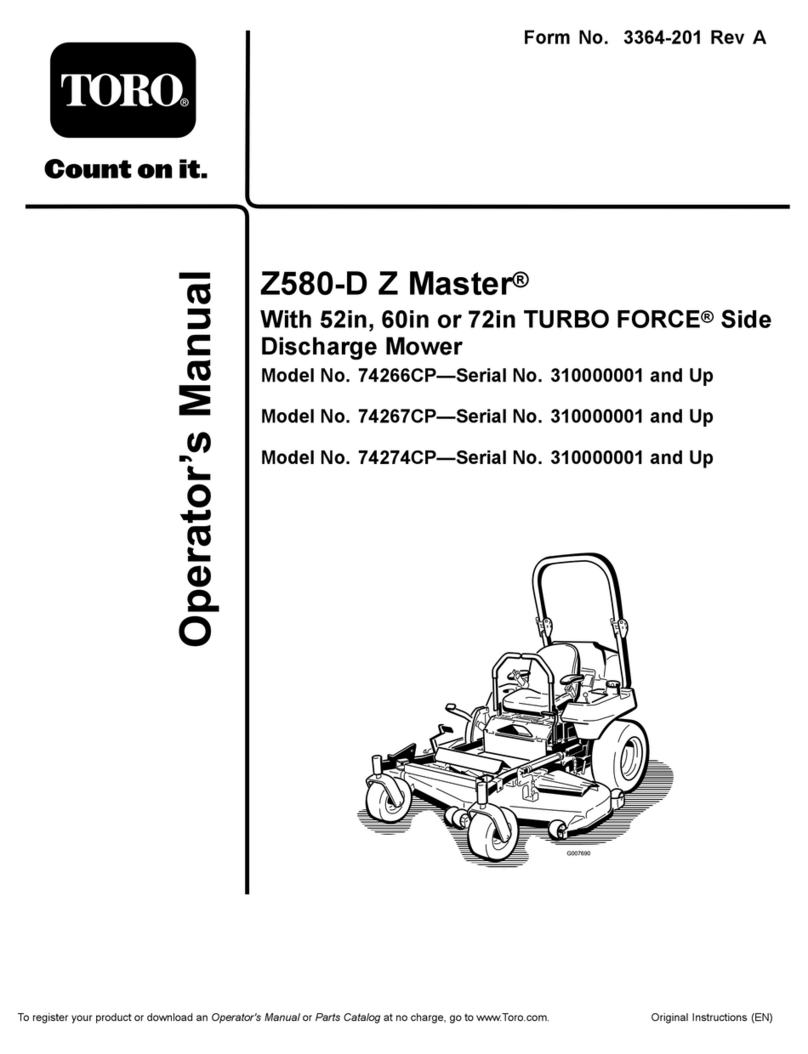
Toro
Toro Z580-D Z Master 74266CP Operator's manual
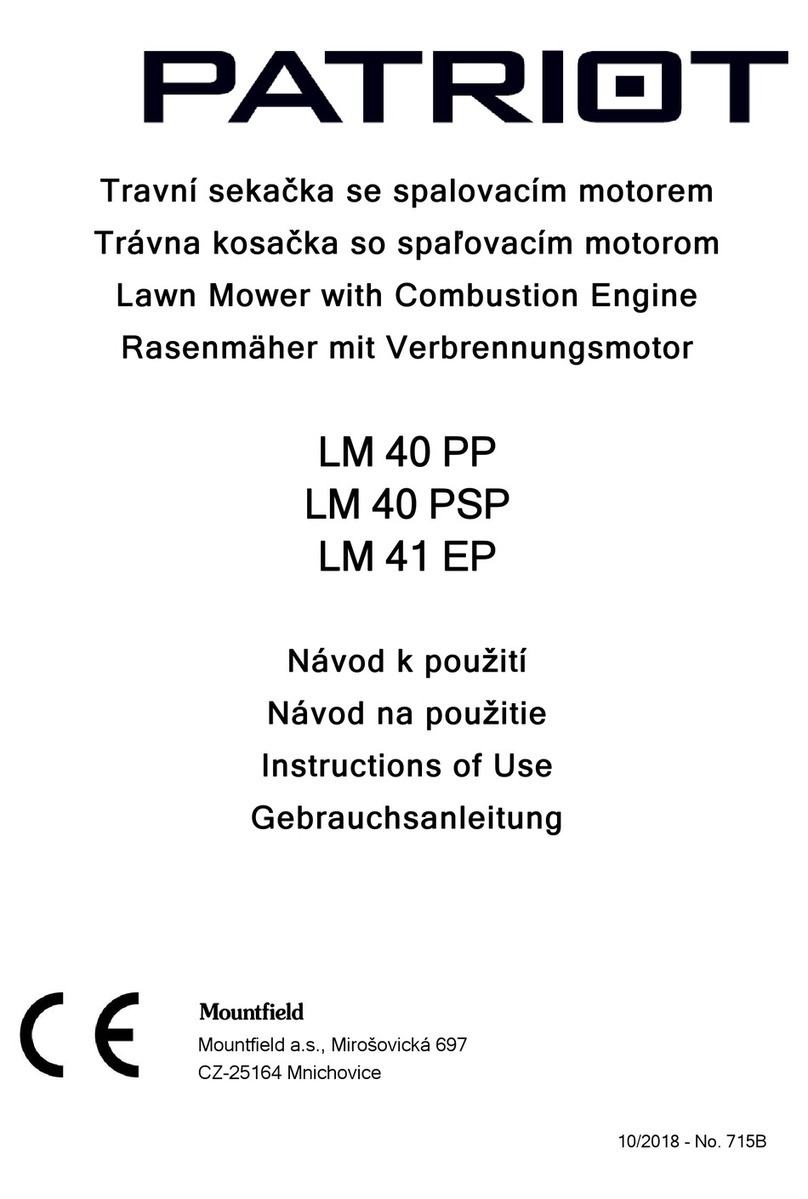
Patriot
Patriot LM 40 PP Instructions for use
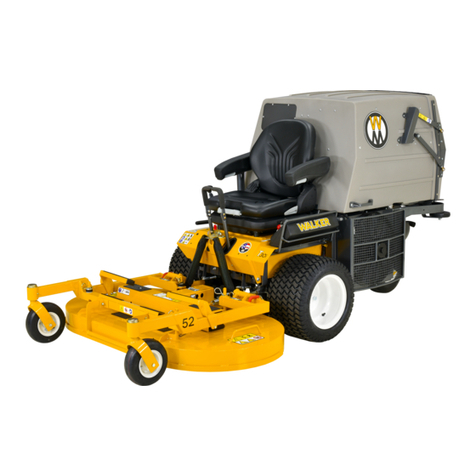
Walker
Walker T Series Operator's Manual Safety, Assembly, Operating, and Maintenance Instructions

Stihl
Stihl FSA 86 R instruction manual
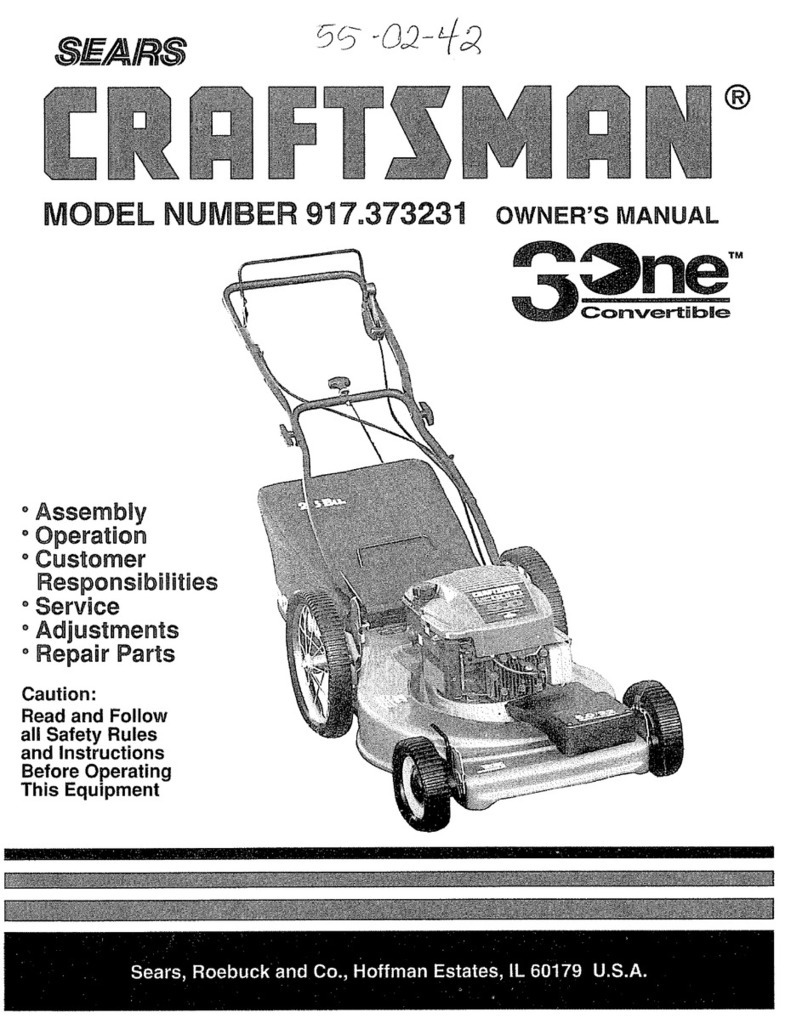
Craftsman
Craftsman 917.373231 owner's manual
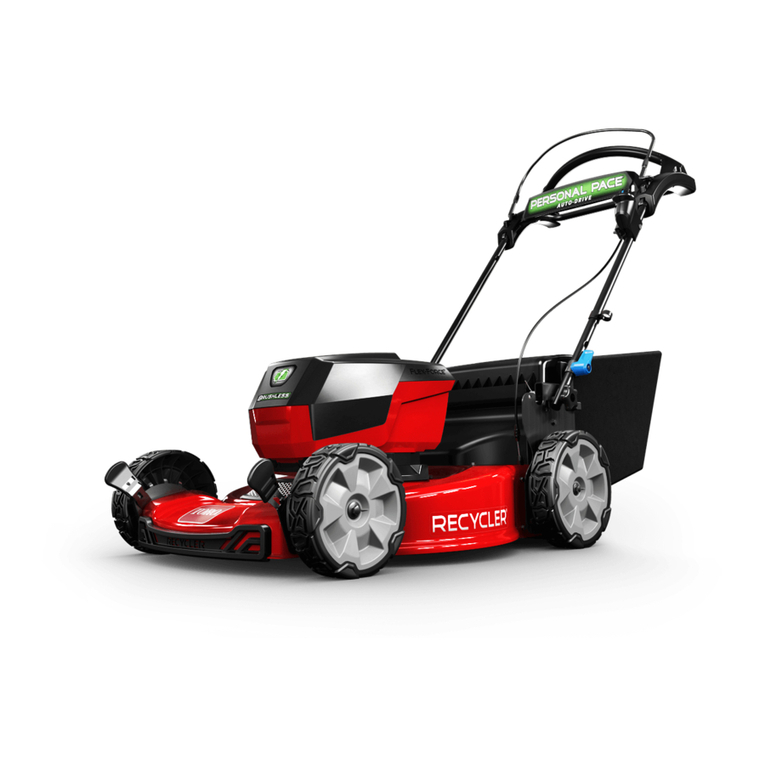
Toro
Toro Flex-Force Power System 21466 Operator's manual

